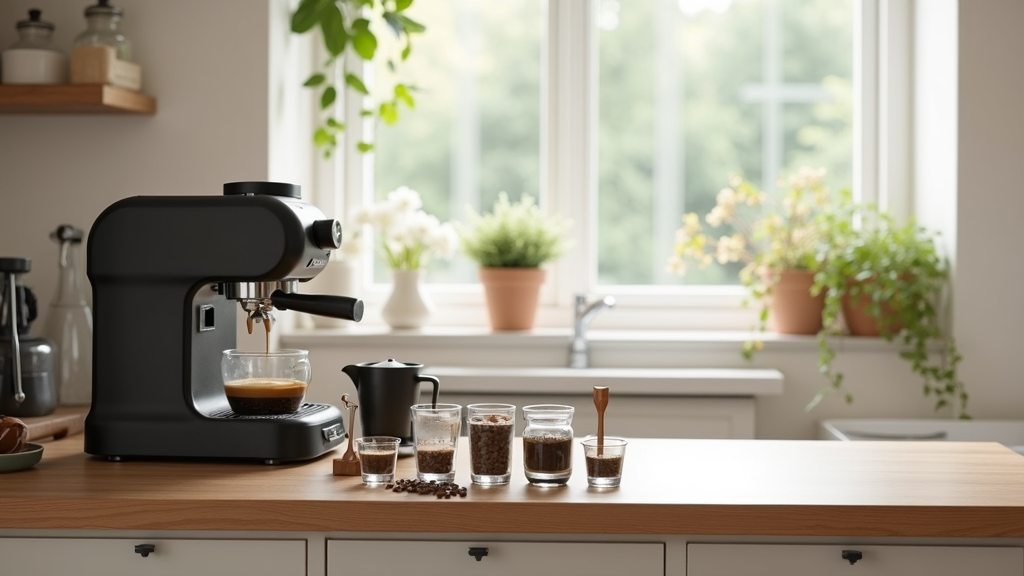Pulling your own espresso shot at home is incredibly satisfying. There’s a reason so many people get obsessed with this little ritual. Everything from the fresh aroma to the first sip is worth the effort. I started my espresso adventure because I wanted that coffee shop taste in my kitchen, and along the way, I picked up plenty of tips, tricks, and gadgets that truly make a difference. If you’re just starting out or you want to take your routine up a notch, you’re definitely in the right spot.

Why Making Espresso at Home Feels So Good
There’s something personal about dialing in your own espresso. I love visiting a cool cafe, but making a very tasty shot at home often feels like a mini victory. You pick your beans, tweak your technique, and watch the shot brew right in front of you. Plus, it saves money, gives you creative control, and genuinely makes mornings a bit brighter.
This site is all about helping you nail the details, no matter what gear you use, how much your budget is, or how much space you’re working with. The world of espresso can seem complicated at first, but I’ll help break it all down into simple steps and honest reviews so anyone can get quality results at home.
Getting Started: What You Really Need for Home Espresso
The basics for home espresso aren’t out of reach. Here’s what I’d put on any starter list:
- Espresso Machine: From budgetfriendly to featurepacked, picking a machine is your biggest choice. More on choosing the right one in a second.
- Grinder: Freshly ground beans are super important for flavor and crema. Burr grinders are the best option for consistency.
- Quality Coffee Beans: Espresso really spotlights bean quality. I’ll check out reviews and give tips on choosing beans below.
- Tamper: This tool helps pack your grounds evenly for a solid shot.
- Scale: Making coffee is both art and science, and weighing your coffee and water makes it simple to repeat what works.
- Milk Frother/Steam Wand (optional): For lattes, cappuccinos, and more, this is useful.
I didn’t buy everything at once, and you don’t have to either. Start with the basics and upgrade as you get more into it.
Choosing and Reviewing Coffee Beans for Espresso
Beans truly are the heart of espresso. I’ve tested dozens of roasts, from chocolatey classics to fruitforward single origins, and my advice is to experiment a bit. Some people go for dark, oily beans for that oldschool Italian vibe, while others love the lighter roasts that highlight fruity or floral notes. Freshness is a real game changer; beans within two to four weeks of roasting usually shine most in the cup.
I’m always exploring new beans from local roasters or online stores, and I share honest reviews focusing on flavor, value, and how well they pull as espresso. If you want to learn how to dial in your own beans or you’re looking for recommendations that work for beginners, you’ll stumble upon plenty of options and tips throughout this site.
Every time I try a new bag, I pay attention to flavor notes, how easy it is to get a consistent extraction, and whether the beans hold up well for milk-based drinks or are better as straight shots. Single origin beans are fun to play with, while blends can be forgiving for new home baristas.
Espresso Machines: Which One Should You Get?
The variety of espresso machines these days is pretty wild. There’s something for every budget and personality. Here’s a quick breakdown:
- Manual Machines: Perfect for real hobbyists who want total control, but the learning curve is steep. It’s rewarding if you love tinkering!
- SemiAutomatic: These let you handle major steps like grinding, tamping, and controlling brew time, but with a little more userfriendliness.
- Automatic: Buttonoperated and straightforward. They’re popular for convenience. Just fill the portafilter and hit start.
- SuperAutomatic: The machine does everything, including grinding. These are awesome if you want coffee fast, with almost no fuss.
I review espresso machines, from solid starter picks to highend models that offer a true cafe experience. My reviews size up build quality, how easy they are to use, cleaning, and shot quality, so you can find a machine that matches your needs and fits your counter.
Essential Coffee Accessories
While not strictly necessary, a few accessories do give your home setup a boost. Starting with a sturdy scale and tamper makes a noticeable difference. Other useful add-ons:
- Distribution Tool: Helps spread your grounds evenly before tamping, which improves extraction.
- Shot Glass or Tiny Pitcher: Lets you monitor shot volume and time.
- Milk Pitcher: Great for practicing latte art or just getting consistently smooth microfoam.
- Knock Box: Makes cleaning up used espresso pucks easy and messfree.
- Group Head Brush: Keeps the crucial parts of your machine clean.
As your skills improve, these tools can really step up your espresso game and smooth the way for daily brewing.
Step-by-Step: Pulling Your First Espresso Shot
Here’s an easy workflow I turn to almost every day:
- Weigh and Grind: Measure your beans—18 to 20 grams works well for a double—and grind to a fine, tablesaltlike texture.
- Distribute and Tamp: Even out your grounds, then tamp them down firmly. You’re aiming for a level, compact surface.
- Flush and Insert the Portafilter: Run some water through your group head to heat things up, then lock in the portafilter.
- Start the Brew: Brew for about 25 to 30 seconds for a double shot. Watch for a silky, honeylike stream—this is your sweet spot.
- Taste and Adjust: Too bitter? Go coarser on the grind. Too sour? Try finer or tweak the brew temp.
It may take a few tries to pull a shot you really love. Tweaking and learning is part of the fun, so enjoy every step. No need to stress about perfection—just keep learning.
The Science (and Art) Behind Espresso
Espresso is both science and creativity rolled into one. The magic comes from balancing grind size, water temperature, pressure, and brew time. Tools like a scale and timer help you repeat your successes, but tinkering with each variable will make your coffee match your unique taste.
Pay attention to water quality, fresh beans, and keeping your machine clean. These all change your final result. There are plenty of resources and online spaces—Reddit’s r/espresso is a favorite—where you can swap tips, troubleshoot, and swap stories with other espresso fans at home.
Home Espresso FAQs
People always check in about these common concerns when starting espresso:
What’s the best way to store beans?
Keep beans in an airtight container, away from heat and light. Skip the fridge or freezer for bags you use every day, since moisture is the enemy of fresh flavor and crema.
Can I make espresso without an espresso machine?
While moka pots or AeroPress with special filters can brew strong coffee, true espresso needs high pressure. Still, those alternatives are useful and affordable for brewing robust coffee at home.
Is a grinder really that important?
Absolutely—a grinder makes a bigger difference than most people realize. Using fresh ground beans leads to better crema and fuller flavor each time.
How do I clean my espresso machine?
In short, often! Wipe down the portafilter and steam wand after every use. If your machine allows, run a cleaning cycle or backflush about once a week. Keeping it clean improves both taste and longevity.
Explore, Experiment, Enjoy
Home espresso is meant to be fun and rewarding. You’ll find super detailed machine guides, honest coffee bean reviews, and helpful tips for getting more from all sorts of coffee accessories here. Whether you’re building your morning ritual or chasing after the sweetest shot, my guides aim to make the process friendly and approachable. Stick around, mix in some variety, and let me know how your espresso adventure is going. After all, the best coffee is the one you love most.

Wow! THis is so exciting for those who love coffee from scratch.Espresso, it is!
NOt for me, though. I’m always in a hurry, thus I just settle for instant coffee, lol!
I envy people who really indulge and make their own espresso in their homes.
The aroma of coffee will make or break you.
Hopefully someday, I can make my own Espresso at home.
Thanks for the tips.
Marita
Thank you so much Marita!
I really enjoyed how approachable and encouraging this post was for anyone looking to get started with espresso at home. The step-by-step breakdown makes the process feel a lot less intimidating, and the equipment tips are super practical. I especially appreciated the focus on experimenting and enjoying the journey rather than chasing perfection. It’s clear you’ve put in a lot of hands-on experience. What espresso machine would you recommend as the best balance between price, ease of use, and quality for beginners?
Hello and thank you Rob. I live in regional, rural Queensland, Australia so enjoying espressos far from the cities is really important. I have a Bezzera which is a wonderful machine, but priced a little higher than entry machines. The machines are all really good now, even than entry levels have the ability to allow the homeowners to make cafe level espressos, and with great beans and knowledge, even better that what some cafes produce.
There is nothing more satisfying than experimenting with your own brews at home. Just that aroma in your kitchen is worth the trouble. As you point out, you can save a lot of money by doing this at home, rather than buying a shot on your way to work.
The best part is trying all the flavors and finding the one that you enjoy, and this you can find in any coffee shop once you have your personal blend mastered.